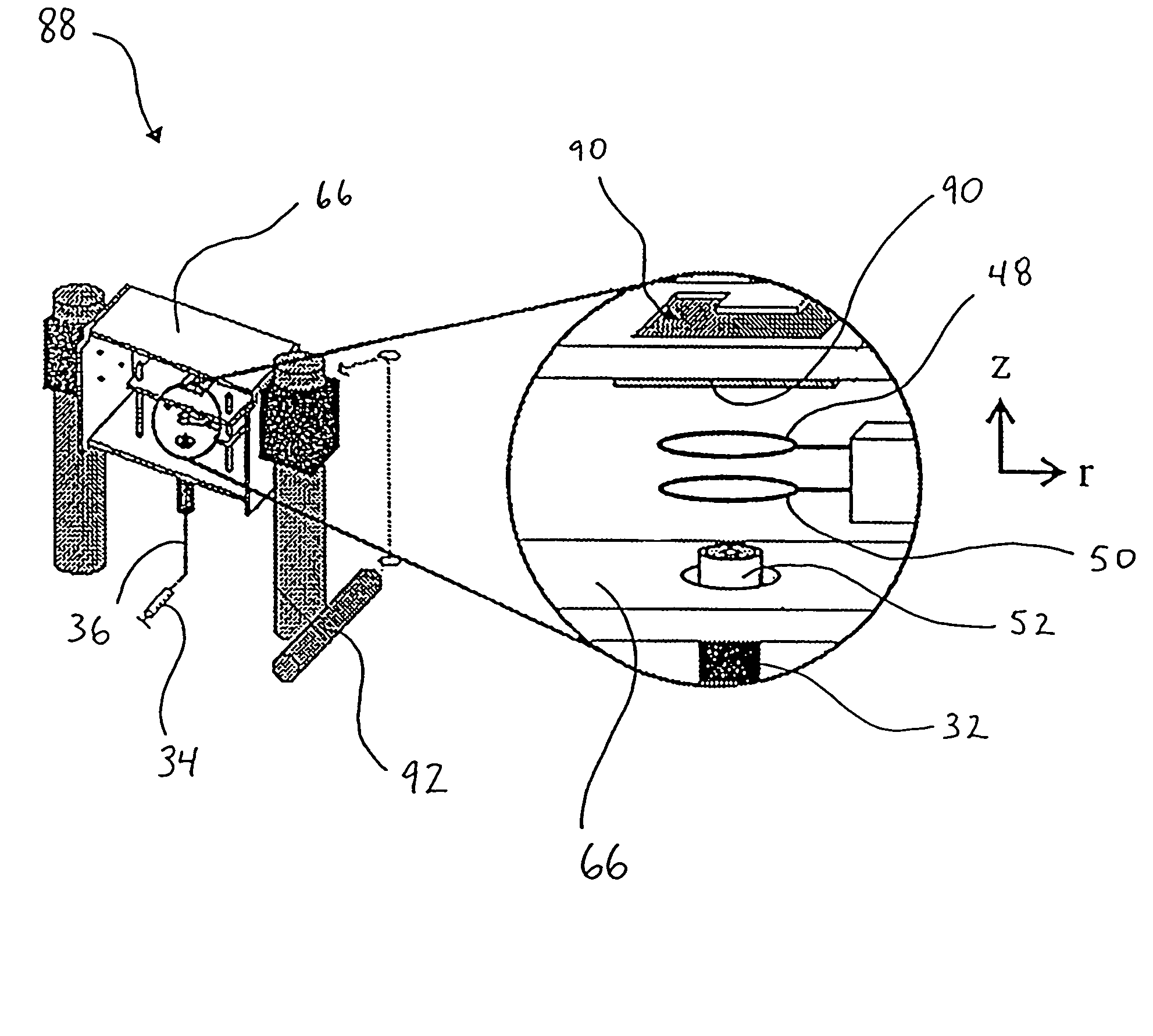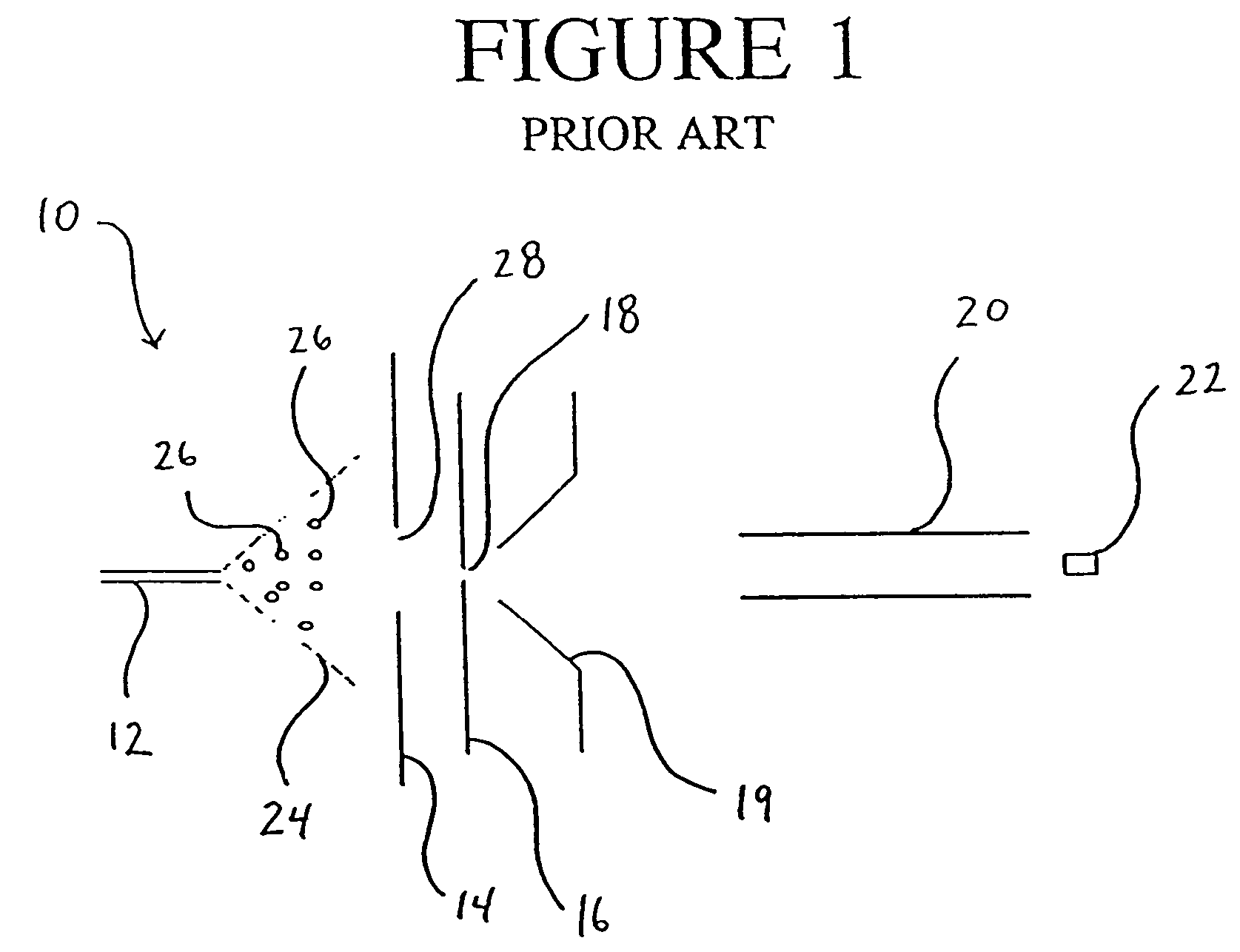Method and apparatus for producing a discrete droplet for subsequent analysis or manipulation
a technology of discrete droplets and droplets, which is applied in the direction of biochemistry apparatus and processes, separation processes, particle separator tubes, etc., can solve the problems of large molecules of biological origin such as proteins, peptides and strands of dna and rna, and the inability to identify proteins that are expressed at low levels. , the problem of 0.01% or less of the sample material is used, and the difficulty of ionizing large molecules of biological origin
- Summary
- Abstract
- Description
- Claims
- Application Information
AI Technical Summary
Problems solved by technology
Method used
Image
Examples
example 2-6
[0117]Examples 2-6 relate to the use of droplet generator 32 and levitation device 30 to deposit sample onto a MALDI plate 90 for subsequent mass spectrometry.
[0118]The following apply for each of Examples 2-6:[0119](a) an apparatus substantially the same as the apparatus 88 of FIG. 10 was used to generate droplets, induce a net charge thereon, levitate the droplets in the electrodynamic balance and deposit the droplets onto MALDI plates. In one instance, the droplets were deposited onto a MALDI plate pre-coated with matrix, while in another instance, the matrix was added directly to the starting solution and the plates were not matrix pre-coated;[0120](b) following droplet deposition, the MALDI plates were removed from the electrodynamic balance chamber and analyzed using a Perseptive Biosystems Voyager-DE MALDI-TOF-MS;[0121](c) the analytes used were Chenodeoxycholic acid diacetate methyl ester and leucine enkephalin, while the matrix was α-cyano-4-hydroxycinnamic acid (HCCA). NaC...
example 2
[0125]FIGS. 12A, 12B and 12C are photographs (magnification 5×) illustrating, in sequence, the levitation of charged droplets within the electrodynamic balance 30, and the ejection of a single droplet from within the electrodynamic balance 30. The photographs were acquired with a digital camera focused through a single microscope objective lens. The motion of a levitated droplet was at 60 Hz, the same frequency as the AC waveform applied to the ring electrodes of the electrodynamic balance. The frequency of oscillation of the droplet's trajectory was faster than the shutter speed of the camera, thus the droplets levitated in the electrodynamic balance appear in FIGS. 12A-12C as lines.
[0126]In the sequence from FIGS. 12A to 12C, the DC potential applied to the induction electrode (+125 V) and the AC trapping potential (1150 V0-p) were held constant while the DC potential applied to the MALDI plate was increased from +150 V to +300 V. FIG. 12A represents a DC potential of +150 V appli...
example 3
[0128]FIGS. 13A and 13B illustrate the results of different approaches for deposition of particles onto a MALDI plate 90. The photographs of FIGS. 13A and 13B were acquired by focusing a digital camera through a microscope. The magnification of FIG. 13A is 20× and the magnification of FIG. 13B is 25×. The number “45” appearing in FIGS. 13A and 13B was etched into the MALDI plate by the manufacturer.
[0129]FIG. 13A is a photograph of a MALDI plate 90, pre-coated in matrix 100, after the deposition of seven droplets 102 (circled for illustration purposes) simultaneously (or near simultaneously) ejected from the electrodynamic balance 30. Simultaneous ejection of the particles occured with the application of a single large potential pulse. In the case of FIG. 13A, the single pulse applied to the MALDI plate 90 was +850 V. This caused near instantaneous removal of the droplets 102 from the electrodynamic balance 30. In doing so, the relative positions of the levitated droplets at the ins...
PUM
| Property | Measurement | Unit |
|---|---|---|
| voltage | aaaaa | aaaaa |
| diameter | aaaaa | aaaaa |
| time | aaaaa | aaaaa |
Abstract
Description
Claims
Application Information
 Login to View More
Login to View More - R&D
- Intellectual Property
- Life Sciences
- Materials
- Tech Scout
- Unparalleled Data Quality
- Higher Quality Content
- 60% Fewer Hallucinations
Browse by: Latest US Patents, China's latest patents, Technical Efficacy Thesaurus, Application Domain, Technology Topic, Popular Technical Reports.
© 2025 PatSnap. All rights reserved.Legal|Privacy policy|Modern Slavery Act Transparency Statement|Sitemap|About US| Contact US: help@patsnap.com



